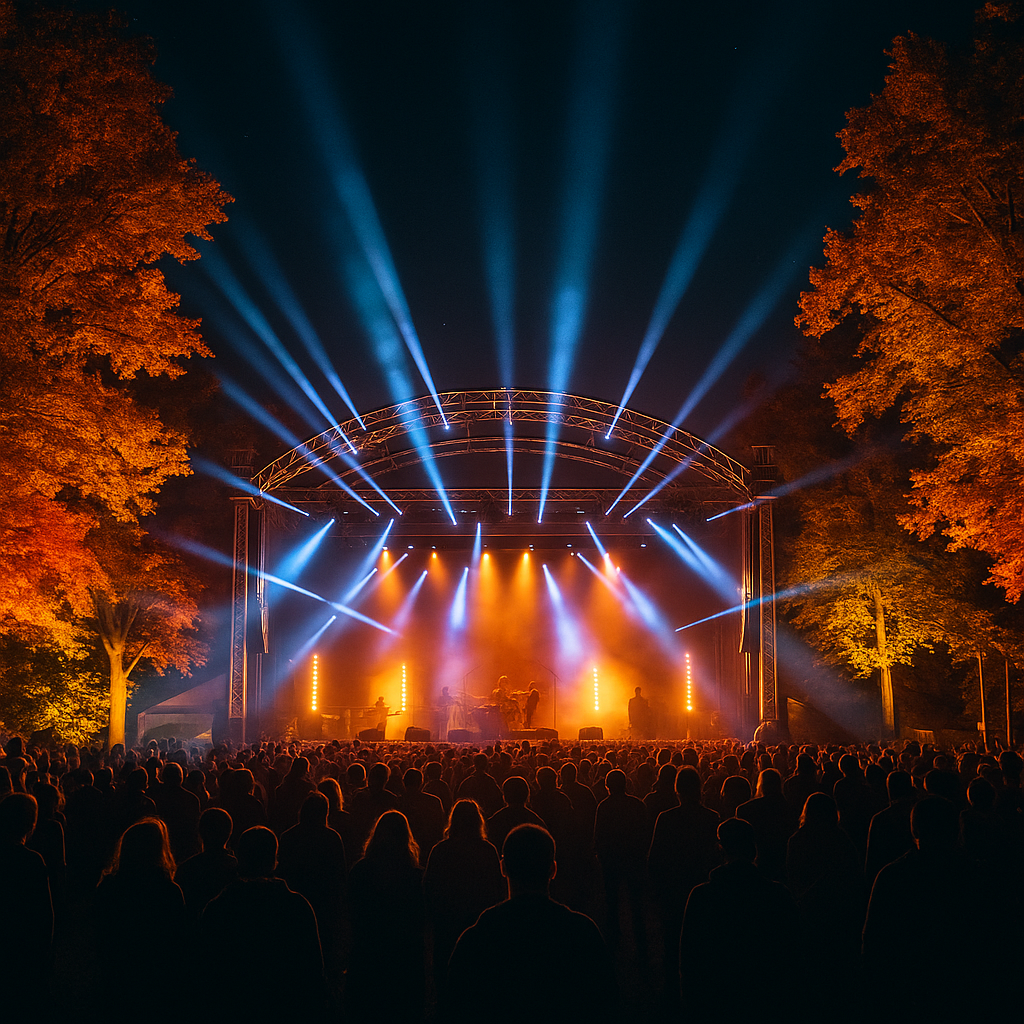Introduction: The Magic of Autumn Festivals
Autumn music festivals hold a unique charm—crisp evening air, colorful leaves, and a season that bridges the warmth of summer with the intimacy of winter. Lighting plays a crucial role in defining the atmosphere of these events. A well-crafted nighttime lighting design not only highlights performers and stages but also guides the audience, enhances safety, and sets the emotional tone for the entire festival.
In this article, we present a detailed Autumn Music Festival Nighttime Lighting Design Plan, combining artistic creativity, technical expertise, and environmental awareness. With insights inspired by industry leaders like Blue Sea Lighting,we will explore design principles that make festivals unforgettable.

Section 1: Goals of Nighttime Lighting in Autumn Festivals
Aesthetic Enhancement – Creating a visually captivating environment.
Audience Immersion – Blending light with sound to evoke emotion.
Safety and Navigation – Ensuring pathways, exits, and audience areas are visible.
Energy Efficiency – Reducing power consumption while maintaining quality.
Weather Adaptability – Designing lighting setups that handle chilly nights, moisture, and wind.
Section 2: Stage Illumination Strategies
The stage is the focal point of any music festival. Key considerations include:
Front Lighting: Ensures clear visibility of performers. Balanced white light with variable color temperature works best.
Back Lighting: Adds depth and drama by separating performers from the background.
Side Lighting: Highlights motion, particularly for dance and theatrical acts.
Overhead Lighting: Provides flexibility for dynamic effects such as strobes, washes, and spotlights.
Layering these techniques allows designers to achieve both functionality and artistry.
Section 3: Audience Area Lighting
While the stage captures the spotlight, the audience’s comfort is equally important. Lighting must guide and engage without overwhelming.
General Wash Lighting: Soft, low-level lighting to maintain visibility.
Pathway and Exit Lights: Crucial for safety and emergency protocols.
Interactive Lighting: LED wristbands or responsive audience-area lights enhance participation.
The balance ensures audiences remain immersed in the show while feeling secure.
Section 4: Decorative and Environmental Effects
Autumn festivals thrive on atmosphere, and lighting design is key to creating seasonal moods:
Warm Tones: Amber, orange, and red hues evoke the autumn palette.
Projection Mapping: Trees, tents, or buildings can be transformed into living canvases.
Fog and Haze Effects: When combined with beams, they create a three-dimensional experience.
Thematic Elements: Pumpkin-inspired shapes, leaf motifs, or geometric patterns tie into seasonal aesthetics.
Section 5: Sustainability in Lighting Design
Modern festivals must balance spectacle with sustainability. Approaches include:
LED Fixtures: Energy-efficient alternatives to traditional lamps.
Smart Power Distribution: Avoiding unnecessary energy use through timed sequences.
Reusable Structures: Trusses and mounts designed for multiple events.
Eco-Conscious Programming: Designing shows with reduced carbon footprint.
Blue Sea Lighting advocates such practices, ensuring innovation aligns with environmental responsibility.
Section 6: Weatherproofing and Technical Resilience
Autumn nights bring challenges—unexpected rain, wind, or temperature drops. Designers must:
Use IP65-rated fixtures for outdoor resilience.
Ensure cable management is elevated and insulated.
Plan redundant power sources to prevent outages.
Consider operator comfort with protected lighting booths.
These preparations guarantee uninterrupted performances regardless of weather.
Section 7: Creating Immersive Experiences
The heart of festival lighting lies in transforming a concert into an emotional journey. Techniques include:
Music Synchronization: Lighting sequences that pulse with beats.
Dynamic Movement: Fixtures with pan, tilt, and zoom for evolving effects.
Audience Interaction: Lights reacting to crowd noise or movement.
Layered Storytelling: Using light to mark transitions between acts or genres.
These methods ensure festivals leave lasting impressions on attendees.
Section 8: Case Study Inspirations
European Autumn Festivals: Emphasize warm tones and projection mapping onto historic architecture.
American Outdoor Concerts: Focus on scale, with powerful beams cutting across open fields.
Asian Cultural Festivals: Blend traditional motifs with modern lighting for a hybrid aesthetic.
By learning from diverse global practices, designers can create unique, culturally resonant experiences.
Section 9: Practical Planning and Logistics
A successful lighting plan is rooted in organization:
Site Surveys: Identifying natural features to incorporate into designs.
Fixture Placement Plans: Mapping out coverage zones.
Power Calculations: Balancing energy demand with supply capacity.
Rehearsals: Testing sequences under real conditions before the festival begins.
Conclusion: Lighting the Autumn Night
Autumn music festivals thrive on their ability to combine nature’s seasonal beauty with human creativity. A comprehensive nighttime lighting design transforms these events from gatherings into unforgettable experiences.
By focusing on aesthetics, safety, sustainability, and innovation—and by learning from pioneers such as Blue Sea Lighting designers can ensure that every autumn night glows with brilliance, guiding audiences through a magical journey of sound and light.





Blue Sea Lighting is an enterprise with rich experience in the integration of industry and trade in stage lighting and stage special effects related equipment. Its products include moving head lights, par lights, wall washer lights, logo gobo projector lights, power distributor, stage effects such as electronic fireworks machines, snow machines, smoke bubble machines, and related accessories such as light clamps.
Quick Links
For more questions subscribe to our email








